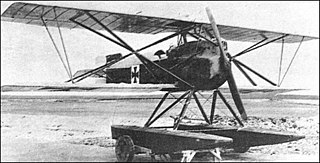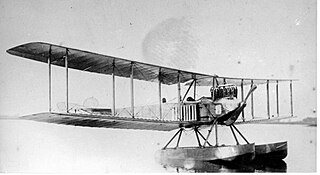
The Albatros W.4 was a military floatplane designed and produced by the German aircraft manufacturer Albatros Flugzeugwerke.

The Rumpler 6B was a German single-engine floatplane fighter with a biplane wing structure, designed and built by Rumpler Flugzeugwerke, in Berlin Johannisthal and introduced in 1916.

The Hansa-Brandenburg KDW was a German single-engine, single-seat, fighter floatplane of World War I. The KDW – Kampf Doppeldecker, Wasser – was adapted from the Hansa-Brandenburg D.I landplane to provide coastal defence over the North Sea.

The Hansa-Brandenburg W.12 was a German biplane fighter floatplane of World War I. Ernst Heinkel's KDW was redesigned, with a rear cockpit, reshaped tailfin, and rudder.

The Hansa-Brandenburg W.29 was a German two-seat fighter floatplane which served in the closing months of World War I with the Imperial German Navy's Naval Air Service from bases on the North Sea coast. In concept the aircraft was a monoplane version of the biplane Hansa-Brandenburg W.12, although there were many structural differences between the two.

Hansa-Brandenburg W.33 was a German two-seat, single-engined low-wing monoplane floatplane, which had been developed by Hansa und Brandenburgische Flugzeugwerke during World War I as a higher powered enlargement of the similar Hansa-Brandenburg W.29 and despite the increase in size the two types are very difficult to differentiate. Although the W.33 was built in small numbers during the war many license built versions were built after World War I.

The Hansa-Brandenburg W.19 was a German fighter-reconnaissance aircraft of World War I. It was a single-engined two-seat biplane floatplane, and was a larger development of the successful W.12. It served with the Kaiserliche Marine during 1918.

The Hansa-Brandenburg CC was a single-seat German fighter flying boat of World War I. It was used by both the Kaiserliche Marine and the Austro-Hungarian Navy.

The Friedrichshafen FF.35 was a German three-seat floatplane torpedo bomber built during World War I by Friedrichshafen Flugzeugbau built for the Imperial German Navy's Naval Air Service. Only one prototype was constructed in 1916 and it saw limited operational use during the war in Courland.

The Lohner L was a reconnaissance flying boat produced in Austria-Hungary during World War I. It was a two-bay biplane of typical configuration for the flying boats of the day, with its pusher engine mounted on struts in the interplane gap. The pilot and observer sat side by side in an open cockpit, and both the upper and lower sets of wings featured sweepback.

The Hansa-Brandenburg W was a reconnaissance floatplane produced in Germany in 1914 to equip the Imperial German Navy. Similar in general layout to the Hansa-Brandenburg B.I landplane, the W was a conventional three-bay biplane with unstaggered wings of equal span. The pilot and observer sat in tandem, open cockpits, and the undercarriage consisted of twin pontoons.

The Hansa-Brandenburg W.11 was a fighter floatplane built in Germany in 1917 as a more powerful version of the KDW. Similar in general configuration to its predecessor, the W.11 shared the same unusual interplane strut arrangement, and featured fins above and below the fuselage. Only three examples were built.

The Hansa-Brandenburg W.13 was a flying boat bomber developed in Germany in 1917 and used by the Austro-Hungarian Navy during World War I.

The Hansa Brandenburg W.27 and W.32 were prototype fighter floatplanes developed in parallel in Germany during World War I. They were developments of and intended replacements for the W.12 then in service and differed from each other principally in the choice of powerplant, the W.27 with a Benz Bz.IIIb and the W.32 with the same Mercedes D.III that the original W.12 used.

The Hansa-Brandenburg W.20 was a German submarine-launched reconnaissance flying boat of the World War I era, designed and built by Hansa-Brandenburg.

The Zeppelin-Lindau CS.I was a German single-engined reconnaissance seaplane with a low-wing monoplane layout.

The Hansa-Brandenburg W.16 was a floatplane fighter built in Germany during World War I for the Imperial German Navy.

The Hansa-Brandenburg W.25 was a German floatplane fighter of the World War I era, designed and built by Hansa-Brandenburg.
The Hansa-Brandenburg W.17 was a German flying boat fighter of the World War I era, designed and built by Hansa-Brandenburg.
The Hansa-Brandenburg W.23 was a German flying-boat fighter of World War I.


















